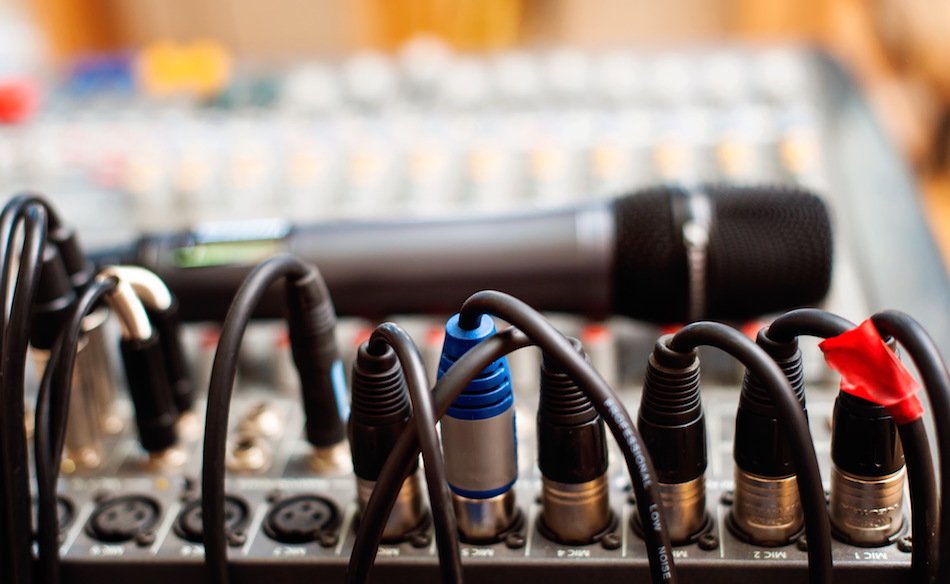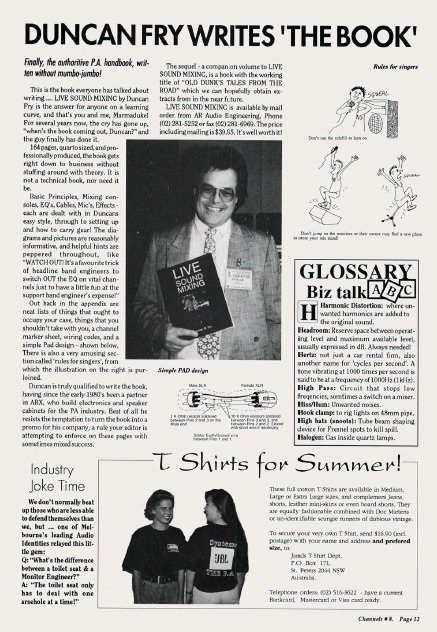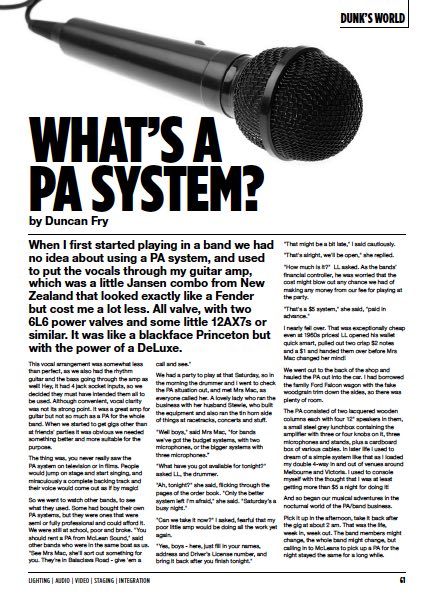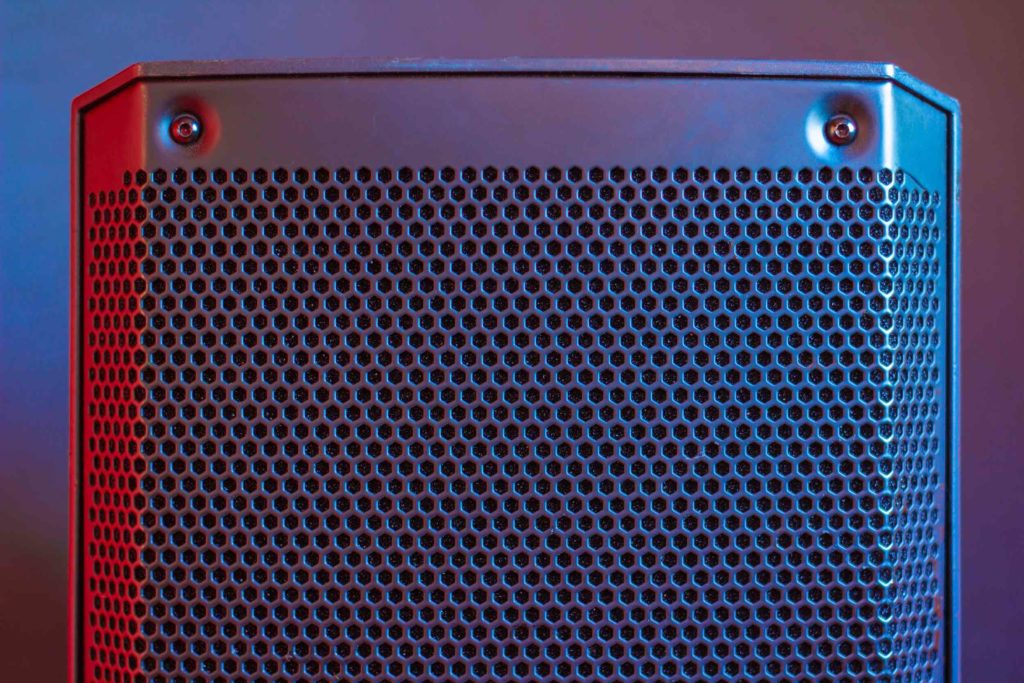Dunk's World
27 Nov 2020
What’s A PA System?

Subscribe to CX E-News
When I first started playing in a band we had no idea about using a PA system, and used to put the vocals through my guitar amp, which was a little Jansen combo from New Zealand that looked exactly like a Fender but cost me a lot less. All valve, with two 6L6 power valves and some little 12AX7s or similar. It was like a blackface Princeton but with the power of a DeLuxe.
This vocal arrangement was somewhat less than perfect, as we also had the rhythm guitar and the bass going through the amp as well! Hey, it had 4 jack socket inputs, so we decided they must have intended them all to be used.
Although convenient, vocal clarity was not its strong point. It was a great amp for guitar but not so much as a PA for the whole band. When we started to get gigs other than at friends’ parties it was obvious we needed something better and more suitable for the purpose.
The thing was, you never really saw the PA system on television or in films. People would jump on stage and start singing, and miraculously a complete backing track and their voice would come out as if by magic!
So we went to watch other bands, to see what they used. Some had bought their own PA systems, but they were ones that were semi or fully professional and could afford it.
We were still at school, poor and broke.
“You should rent a PA from McLean Sound,” said other bands who were in the same boat as us. “See Mrs Mac, she’ll sort out something for you. They’re in Balaclava Road – give ’em a call and see.”
We had a party to play at that Saturday, so in the morning the drummer and I went to check the PA situation out, and met Mrs Mac, as everyone called her. A lovely lady who ran the business with her husband Stewie, who built the equipment and also ran the tin horn side of things at racetracks, concerts and stuff.
“Well boys,” said Mrs Mac, “for bands we’ve got the budget systems, with two microphones, or the bigger systems with three microphones.”
“What have you got available for tonight?” asked LL, the drummer.
“Ah, tonight?” she said, flicking through the pages of the order book. “Only the better system left I’m afraid,” she said. “Saturday’s a busy night.”
“Can we take it now?” I asked, fearful that my poor little amp would be doing all the work yet again.
“Yes, boys – here, just fill in your names, address and Driver’s License number, and bring it back after you finish tonight.”
“That might be a bit late,” I said cautiously. “That’s alright, we’ll be open,” she replied.
“How much is it?” LL asked. As the bands’ financial controller, he was worried that the cost might blow out any chance we had of making any money from our fee for playing at the party.
“That’s a $5 system,” she said, “paid in advance.”
I nearly fell over. That was exceptionally cheap even at 1960s prices! LL opened his wallet quick smart, pulled out two crisp $2 notes and a $1 and handed them over before Mrs Mac changed her mind!
We went out to the back of the shop and hauled the PA out into the car. I had borrowed the family Ford Falcon wagon with the fake woodgrain trim down the sides, so there was plenty of room.
The PA consisted of two lacquered wooden columns each with four 12″ speakers in them, a small steel grey lunchbox containing the amplifier with three or four knobs on it, three microphones and stands, plus a cardboard box of various cables.
In later life I used to dream of a simple system like that as I loaded my double 4-way in and out of venues around Melbourne and Victoria. I used to console myself with the thought that I was at least getting more than $5 a night for doing it!
And so began our musical adventures in the nocturnal world of the PA/band business. Pick it up in the afternoon, take it back after the gig at about 2 am.
That was the life, week in, week out. The band members might change, the whole band might change, but calling in to McLeans to pick up a PA for the night stayed the same for a long while.
It was a time before the use of the PA as a complete sound system to mic up every instrument. All we did was put the vocals through it, and maybe hang a mic over the drums if required.
If you needed more guitar volume you had to turn it up and, when that didn’t work, you bought a bigger amp! So I sold my little Jansen amp and have regretted it ever since.
It had a great sound and not once stopped working – and you can’t say that about many guitar amps! But I needed a louder amp so I bought a 60W Strauss ‘Polka’ amp head from Gary Nessel [‘In Memory of Gary Nessel and Strauss Sound Systems‘ – CX Network] with two speaker boxes each fitted with two of the classic Celestion G12M speakers in each of them.
Then I got a cabinetmaker to build me a Marshall shaped double stack, and put all four speakers into the top angled box. I used just the top angled cabinet for small gigs and for big gigs just sat it on the empty bottom box!
Image was everything and bigger was obviously better.
The prices gradually changed, but Mrs Mac was always there to book a system out and welcome it back in at all hours. Some nights their son Young Hughie would be wandering around in his pyjamas, absorbing the nuts and bolts of running the business.
One night drummer LL, bass player RH Positive and I dropped the system back to the shop and Stewie was busy testing out a big system for Flemington Racecourse – I think it might have been for the Melbourne Cup, but I couldn’t swear to it.
There were tin horns and speaker boxes piled up everywhere as well as quite literally kilometres of cable.
“Have a listen to this, fellas” he called out.
‘WEEEEEEEE’ A monster burst of feedback shredded our eardrums and we ran outside screaming, our hands pressed over our ears. Stewie stood there unfazed, and leant over to turn it down.
He turned to us, chuckling and “That bother you, does it, boys?”
Stewie actually did the PA for the Queen’s visit, where she was going to speak to a huge crowd that had gathered in the city. Unfortunately when she spoke she couldn’t be heard.
It turned out her security people wouldn’t let Stewie through the crowd to turn the system on.
Eventually they had to let him through, and then it all went off without a hitch. But the next day’s morning newspaper had a picture of a smiling Stewie holding an SM58, and in the accompanying story, not holding back with his opinion of the Queen’s security people.
In big type the headline read SOUNDMAN NOT LOST FOR WORDS!
Duncan Fry went on to write the book ‘Live Sound Mixing’, extracts of which would occasionally feature in Connections Magazine.

CX Magazine – November 2020
LIGHTING | AUDIO | VIDEO | STAGING | INTEGRATION

Entertainment technology news and issues for Australia and New Zealand
– in print and free online www.cxnetwork.com.au
© VCS Creative Publishing
Subscribe
Published monthly since 1991, our famous AV industry magazine is free for download or pay for print. Subscribers also receive CX News, our free weekly email with the latest industry news and jobs.







